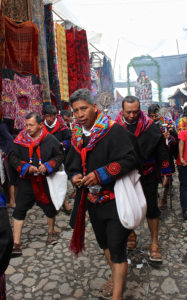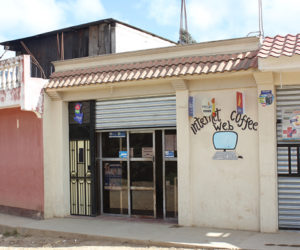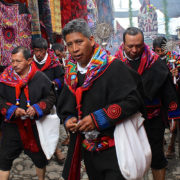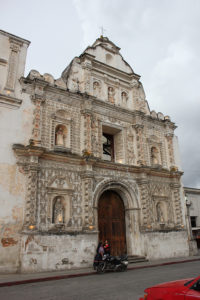Shining a Light on Untapped Resources for Behavior Change Communication in Guatemala
The complex social, cultural, and communication landscape in Guatemala
When the Health Communication Capacity Collaborative (HC3) Guatemala team began its pre-strategy situation analysis in Guatemala, staff noted the uniqueness and complexity of the country within the broader landscape of Latin America.

Mayan priests walk through the streets of Chichicastenango in the Western Highlands of Guatemala. Photo credit: Patricia Poppe
The country’s cultural profile is incredibly diverse, with a large percentage of the population identifying as indigenous, mostly from one of the four primary Mayan indigenous groups: K’iche’, Q’eqchi, Kaqchikel, and Mam. Twenty-two non-Spanish indigenous languages are spoken in the country. Additionally, whereas the vast majority of the population of Latin America is of the Catholic faith, Guatemala has a complex and multifaceted spiritual landscape: while 50% of Guatemalans do identify as Catholic, 41% identify as Protestant, with many of those identifying as Protestants belonging to unique and individual evangelical belief systems and churches, especially Pentacosalism. It is estimated that within Guatemala, there are at least 300 individual religious communities.
Guatemala also has high levels of access to communication channels and platforms, even within the Western Highlands of Guatemala where poverty can create great economic challenges. An extraordinary menu of radio stations and programs exist in Guatemala. Radio is transmitted via national radio stations, district/department-level radio stations, as well as “pirate” radio stations at the community level that operate without any registration. Even in the most remote areas of Guatemala, it is still possible to listen to the radio. Additionally, mobile phones are very accessible to those of all socioeconomic backgrounds, and are commonly owned in households of all income levels throughout the country. Rates of mobile phone ownership throughout the country are very high, with most individuals owning basic phones capable of calling and texting, but smartphone ownership is on the rise. While access to internet is somewhat low, it is also increasing with the diffusion of smartphones and improved infrastructure throughout the country.
Gathering Insights and Evidence
Before designing its social and behavior change communication (SBCC) strategy and platforms, HC3 Guatemala sought to better understand how the powerful forces of religion, mobile phone ownership and use, social media and internet use and radio programming can be better utilized to promote healthy behaviors in the Western Highlands of Guatemala. With the support of the USAID Mission in Guatemala, the project designed three landscaping studies as part of a broader formative research agenda to examine these unique influences on the lives of the intended participants of HC3 Guatemala’s planned program. Using qualitative methods such as focus group discussions, key informant interviews, and direct observation, the team gathered vital insights that they then fed into the creation of a recently completed SBCC strategy.
Landscaping Study Findings
Regarding the role that religious leaders play in the lives of residents of the Western Highlands of Guatemala, the collected data suggests that churches have a large presence in the communities, and religious leaders live among their constituents. Religious leaders also work in their communities, helping the sick, the widowed, and young married couples. They frequently incorporate themes of development and health into their sermons, and the majority of those interviewed expressed interest in collaborating with HC3.
During a landscaping study conducted with radio stations and radio listeners, HC3 Guatemala learned that radio has a high level of penetration throughout the Western Highlands, with the majority of radio stations focusing on religious topics. Radio listeners say that they keep the radio on to hear the news, hear sermons, listen to music, and to feel entertained or accompanied during their daily work. Women listen to the radio at higher rates than other groups, and young people stated that they listen to the radio on their mobile phones. The most popular programs are religious, followed by music and news. Three quarters of the radio stations interviewed incorporate advice and tips on health and development topics into their programs, with health being the most popular with listeners. Nearly 90% of radio station representatives interviewed said that they would be interested in collaborating with non-governmental organizations on development and health programs. Though many development projects in the Western Highlands have collaborated with radio stations in the past, these initiatives have not included long-running campaigns for social and behavior change.

An internet cafe in Momostenango in the Western Highlands of Guatemala. Photo credit: Patricia Poppe
Study participants reported that ownership and use of mobile phones has increased dramatically during the last 5 to 10 years, due to improvements in mobile signal, decrease in the price of phones, and to better communicate with loved ones living in the United States. Young people tended to have nicer, more advanced smartphones, while older adults were more likely to have simple phones that they tended to keep and use for many years. Men, young people, and married women were most likely to own cell phones. Additionally, those with more advanced cell phones expressed that they depended greatly on apps such as Facebook, Tango, Imo, Line, and WhatsApp to communicate with friends and loved ones. Mobile phone users expressed interest in receiving information about health, nutrition, agriculture, hygiene, and the environment on their phones.
Conclusion
These studies provided new and important insights on three avenues for engagement that have, to date, been underutilized for social and behavior change communication. HC3 Guatemala is ensuring that these insights are fully integrated into its recently finalized SBCC strategy, and is making plans to engage its audience through these avenues and platforms during program implementation in 2017.









Leave a Reply
Want to join the discussion?Feel free to contribute!